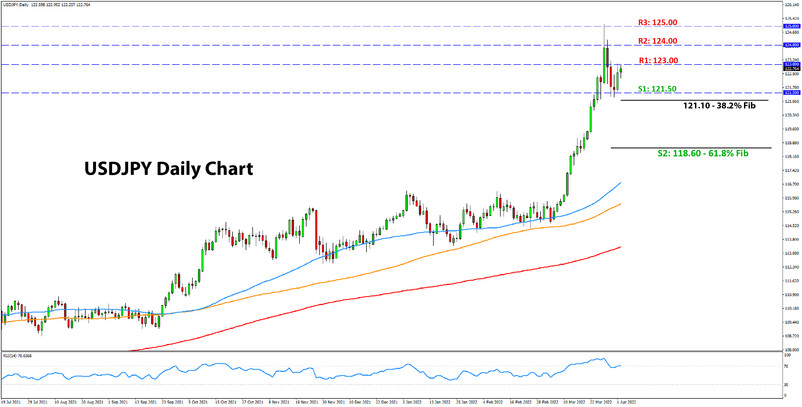USD Weekly Fundamental Outlook: Dollar Stays Firm, Albeit Still Inside Consolidative Range
The dollar stays generally supported, although it didn’t break to new cycle highs and is still trading inside its broader consolidation pattern that goes back to early March (i.e., DXY index). The solid jobs and NFP reports last Friday boosted hawkish expectations for more potent Fed rate hikes, with futures markets now expecting two 50bp rate hikes in May and June (this would take Fed interest rates to 1.5% by summer already).
Other economic data from the US also supports the case for more aggressive Fed tightening. Inflation remains high while leading economic surveys such as the ISM PMIs remain at healthy levels. All this suggests that the Fed can be forcefully hawkish, if not for longer, at least in the next several months, before the rate hikes start to slow down the economy (perhaps Q4 2022). Thus, the hawkish Fed, combined with the strong US economy in contrast to peers (mainly Europe), should continue to support the US dollar in the foreseeable future.
Still, given all this hawkishness, the dollar is only moderately strengthening so far, except for the faster appreciation against the weak Japanese yen. Again, this is a “healthy” reminder that Fx trading is a relative game. While the Fed is hawkish because inflation is high, so are other central banks (even the ECB) because inflation is high everywhere. This is acting as a setback to larger USD gains at the moment; however, the weaker Eurozone economy should ultimately dampen any hawkish inspiration at the ECB in later months this year, which could keep the USD broadly strong for longer.
This week’s calendar is lighter, and the focus will go on the ISM services PMI survey (Tue) and the FOMC meeting minutes (Wed). Traders will watch the FOMC minutes for discussions around quantitative tightening (QT), where hawkish comments could fuel fresh bullish pressures on the USD.
EUR Weekly Fundamental Outlook: Ukraine Conflict De-Escalation, but Are Sanctions About To Be Stepped Up?
Some may find it strange that the euro is falling now that there has been some withdrawal of Russian troops on the ground in Ukraine (supposed military de-escalation). However, this all goes back to what we have discussed here in the past 4-5 weeks, which is that as long sanctions remain in place, the euro will hardly be able to sustain any material gains.
And it now seems that even stronger sanctions from Western allies on Russia are on the cards, given the horrific images (of war crimes) that circulated in the media over the weekend. Russian gas and oil are still flowing to Europe, but a complete ban would mean that prices in Europe’s energy markets will go through the roof. This is a negative scenario for the EUR currency, and it’s hard to see how Europe can lift sanctions on Russia, especially with the latest news of atrocities in Kyiv’s Bucha suburb. With the sanctions likely to remain in place (potentially permanently or as long as Putin is President), the immediate economic outlook for the Eurozone remains rather grim.
In the meantime, Eurozone economic data showed inflation continued to push higher while business sentiment surveys (PMIs) weakened further. This is all in line with the stagflationary environment, putting the ECB in a really tough spot over the next months of having to choose between fighting inflation or supporting economic growth. The odds are that the negative economic outlook will prevent the ECB from tightening policy as much as others (e.g., the Fed), thus continuing to exert downward pressure on the EUR currency.
The EUR calendar for this week is light, featuring only 2nd tier data like industrial production and retail sales. Fx traders also need to keep an eye on the French Presidential election on Sunday (Apr 10). While sitting President Emmanuel Macron is widely expected to win both rounds, surprises are always possible in politics, so some extra caution here can do no harm.
EURUSD Technical Analysis:
For this week, we turn to the shorter-term outlook on the daily chart, which shows a renewed attempt for EURUSD to break out of its consolidative range to the downside. For some context on the bigger picture (weekly chart), you can also check out the EURUSD technical analysis published last week.
The support line of the consolidative range comes in around the 1.10 level (chart below), with which the price is flirting today. A break to the downside will open the potential for a retest of the 1.08 low from early March. Before it, 1.09 will be a moderate support zone, though in this case, it’s likely to be less significant following a break out of the consolidation.
To the upside, the first resistance on the daily chart would be at the 1.11 round number level. However, the more important resistance is located at the 1.12 area, where the previous highs/lows meet with the 55-day and 100-day moving averages.
GBP Weekly Fundamental Outlook: Pound Underperforms As Focus Remains on Weakening Economy
The pound was one of the worst-performing major currencies over the past week, although without any specific trigger behind the move. Instead, it appears that the markets’ focus remains on the negative outlook for the UK economy, and the currency was sold driven by these longer-term factors.
Like last week, the UK economic calendar is not particularly exciting for the week ahead, except for several MPC members of the BOE that have scheduled speeches. But as on other occasions recently, BOE officials are likely to highlight the downside risks to the economy going forward, at least as much as the upside risks for inflation. Since their last meeting on March 17, when the UK’s central bank raised rates by 0.25% but surprised dovishly, there has been a clear shift at the BOE from a focus fully on inflation to one split evenly between inflation and economic growth.
The change in communication suggests that the BOE doesn’t want to raise rates as aggressively as some hoped previously. Those hawksih market expectations are now being priced out of GBP, putting downside pressures on the currency. Hence, if we keep getting such dovish rhetoric from BOE officials, GBP will be at risk for further losses, especially against the currently “strong” currencies like the USD, CAD, and AUD.
GBPUSD Technical Analysis:
GBPUSD spent the past week consolidating above the 1.31 zone, with the overall tone remaining bearish following the bearish rejection at the 1.33 zone. GBPUSD is also trading below a falling trendline, which keeps the recent bearish move intact. The resistance here is defined at the 1.3150 zone (see chart below).
As long as the trendline holds, a new bearish leg that potentially takes the pair below 1.30 remains a possibility. If, however, the trendline is broken bullishly, then this consolidation may extend and we could see another attempt toward the 1.33 zone.
To the downside, the first support is at 1.30, near the previous low. Below it, 1.2850 is the next important technical zone that can act as a support.

JPY Weekly Fundamental Outlook: Perfect Storm of Bearish Factors Keep JPY Bear Trend Intact
The yen managed to stage a modest recovery last week, though there was hardly a fundamental driver behind it. Instead, the moves seem mostly connected to technical and flow factors helping a much-needed correction to unfold.
The negative “perfect storm” of high commodity prices, uber-dovish BOJ, and a still relatively stable risk environment (stocks holding up well) should keep the JPY weak in the current environment. However, whether this can lead to a new cycle high above 125.00 in USDJPY remains to be seen. Importantly, Japanese officials (both BOJ and Ministry of Finance) don’t seem to mind the yen’s decline and continued to say that a weak yen is good for the Japanese economy. Last week, there were also some reports of former vice Minister of Finance Eisuke Sakakibara saying that as long as USDJPY is below 130.00, it should not cause any problems for Japan’s economy.
With all the key JPY factors pointing in the bearish direction, it’s hard to see the yen staging a notable rebound any time soon. But, some risks to this view are worth keeping in mind, and those again are connected to risk sentiment and Treasury yields. If either or both of those reverse, then it will be much easier for the JPY also to reverse some of its recent losses.
USDJPY Technical Analysis:
USDJPY has apparently started a retracement following the brief touch of levels above 125.00 last Monday. The main question now is whether the retracement is completed with the one down leg so far, or is USDJPY going to trade in a prolonged consolidation?
Some technical zones can be used as guidance in this context to help determine which scenario is likely to play out. To the upside, resistance should exist at the 123.00 and 124.00 zones. These were levels where the price reacted both on the way up and then on the way down during the retracement off the high. The 125.00 area itself, of course, remains an important technical zone.
To the downside, the 121.50 zone, where the retracement stopped, is the first support. It is also very near the 38.2% Fibonacci retracement, at 121.10. Below it, 120.00 will come into focus as the next support, and then the 61.8% Fib retracement lower at 118.60.
Finally, keep the big picture in mind. The trend here is strongly bullish, and upside pressures are likely to remain dominant, regardless of how the correction plays out. In this regard, thus, it makes sense to continue looking for bullish opportunities on dips.






